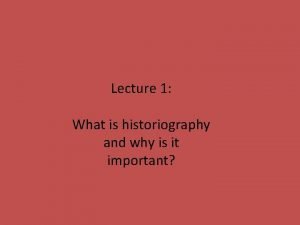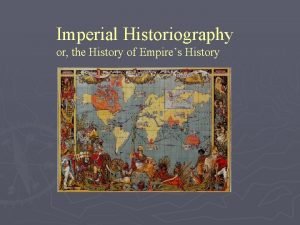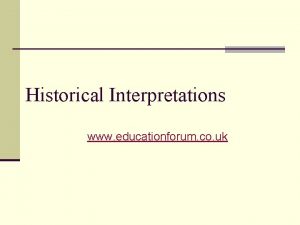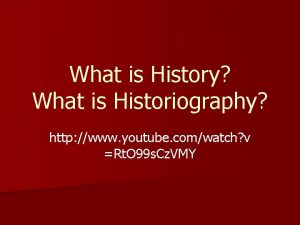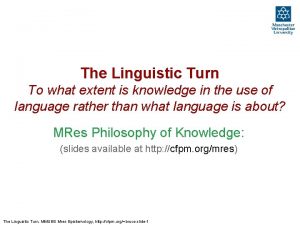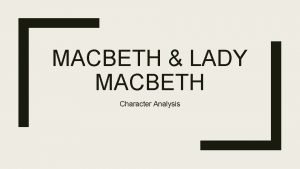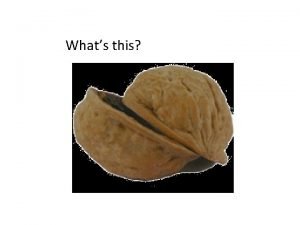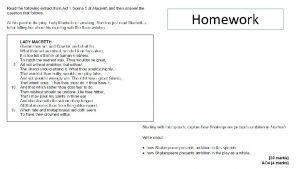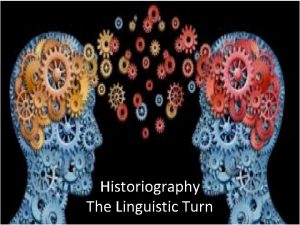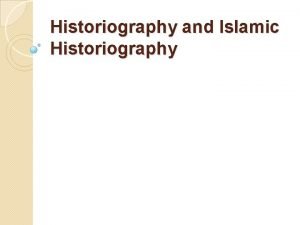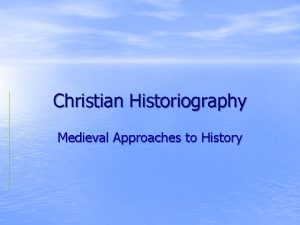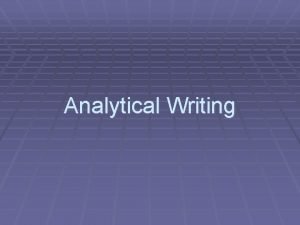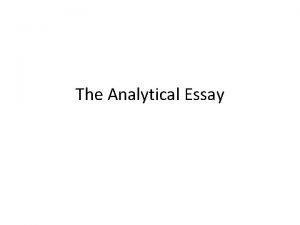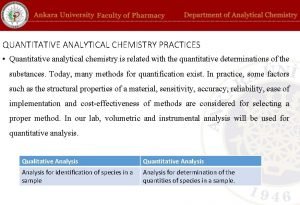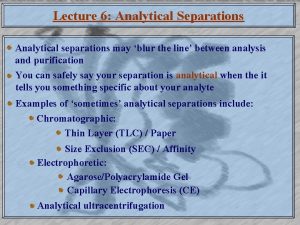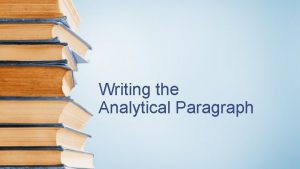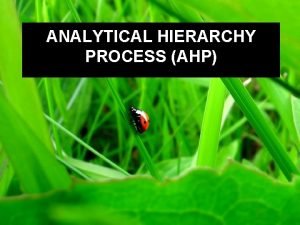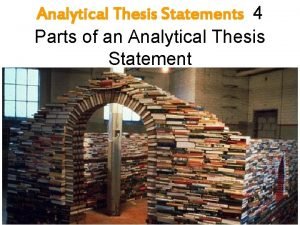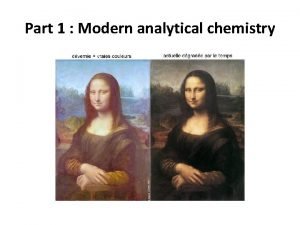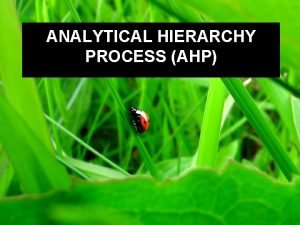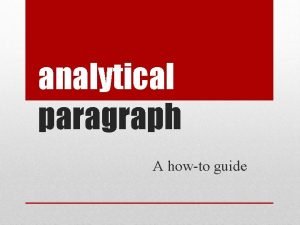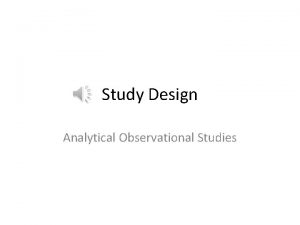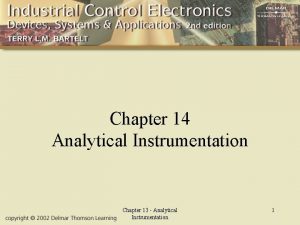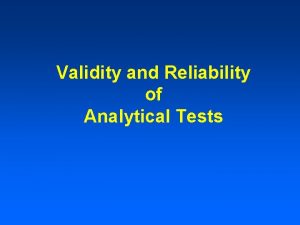Historiography The Linguistic Turn Linguistic Turn Analytical turn










































- Slides: 42

Historiography The Linguistic Turn

Linguistic Turn Analytical turn upon, or problematisation of, words/language used in a given field of study. Also used to refer to the ‘turn’ to linguistic philosophy in the late 20 th century in the humanities and social sciences. Term first used by the philosopher Richard Rorty The Linguistic Turn (1967)

Sorting out the ‘modern’ and ‘post-modern’ Modernity ≠ Modernism

Modernity Definition about the time period varies but it generally refers to historical developments such the rise of capitalism, and the move of Western societies towards industrialization, secularization, rationalization, the nation-state and its constituent institutions and forms of individual and collective surveillance. Modernity may also refer to tendencies in intellectual culture, particularly the movements intertwined with secularisation and industrial life, such as Marxism, and the formal establishment of the social sciences. It extends to the 1960 s. (Some theorists, such as Jurgen Habermas, argue that it continues today. ) Modernism It is a philosophical movement that, along with cultural trends and changes, arose from wide-scale and far-reaching transformations in Western society in the late 19 th and early 20 th centuries. Among the factors that shaped Modernism was the development of modern industrial societies and the rapid growth of cities, followed then by the horror of World War I. Some proponents of modernism also began to reject the certainty of Enlightenment thinking and concepts (progress, rationality, reason, etc. ) and many modernists rejected religious belief (e. g. Friedrich Nietzsche)

Postmodernity This term refers to sociological, political, economical, technological, etc. conditions of everyday life that differ from those of ‘modernity’. Nation-based Industrialisation gives way to transnational production, service industries and corporations. The multiple identities people carry within them are stressed. The networked, rather than essential, aspect of elements in society(-ies) is the focus. Not what things ‘are’ but how things ‘relate’ to each other. The discussion of postmodernity is the discussion of these conditions. Postmodernism Refers to the intellectual, cultural, artistic, academic, and philosophical response to the conditions of postmodern-nity since the 1960 s. It is a also philosophy of knowledge, which stands in contrast to that of the Enlightenment and modernity. It questions rationality and empiricism. It is skeptical about the ability of the empirical method to give us direct access to reality and universal truth. So, it dismantles the entire system of knowledge that was created by Enlightenment empiricism and, starting from scratch, it constructs a new knowledge system, the central premise of which is the rejection of all ‘meta-narratives’

‘What is postmodernism? ’ Jean-François Lyotard (1924 -1998) French philosopher and literary theorist. “Postmodernism is incredulity toward meta-narratives” What are meta-narratives? E. g. : Historical Progress Rise of Democracy and Human Rights Corruption of Society (e. g. Gibbons’s Decline and Fall of the Roman Empire) Class Society

What is Post-modernism? Skepticism about truth claims Biblical view: ‘In the beginning was the Word, and the Word was with God, and the Word was God. ’ Bible: John 1: 1. Enlightenment view (extrapolation): ‘In the beginning was Truth, and Truth was with Knowledge and Truth was Knowledge. ’

Extrapolations • Historicist view: ‘In the beginning was the Spirit and Spirit was with Man and Man would develop according to the Spirit. ’ • Marxist view: ‘In the beginning was Man and Man was with his forces of production and Man’s relation to Man would develop according to changes in the forces of production. ’

Extrapolation • Linguistic Turn View: ‘In the beginning there were humans and humans invented words; words were the basis of knowledge; humans understood themselves and the world through the words they continually reinvented. ’

So, what is at stake in all postmodern writing is the question of ‘reality’ Central claim: It is impossible to show ‘reality’ – only ‘representations’, of ‘reality’ are possible.

• History journal • University of California Press

What postmodernist writings offer • They embrace fluid and multiple perspectives, typically refusing to privilege any one 'truth claim' over another • Ideals of universally applicable truths give way to provisional, de-centered, local petit recits which, rather than referencing some underlying universal 'Truth’ (e. g. Walkowitz City of Dreadful Delight)

‘Heroes’ of postmodern scholarship Ludwig Wittgenstein (1889 -1951) Friedrich Nietzsche (1844 -1900)

Nietzsche’s genealogy of metaphysical concepts • The Genealogy of Morals (1887) – Moral concepts and truth claims are not absolute. They have a history and depend on one’s perspective. • The invention of « I » (me) – Imposes moral responsibility on individual. It opens the door to the moral regulation of the individual… Behind the « I » are social/moral constraints … lonely constraints

Nietzsche: It’s all in your head! • “It is true, there could be a metaphysical world; the absolute possibility of it is hardly to be disputed [irony]. We behold all things through the human head and cannot cut off this head; while the question nonetheless remains what of the world would still be there if one had cut it off. ” – Human, all too human (1878)

Nietzsche What is truth? • ‘To be truthful means using the customary metaphors - in moral terms, the obligation to lie according to fixed convention, to lie herdlike in a style obligatory for all. ’ • ‘What about these linguistic conventions themselves? Are designations congruent with things? Is language the adequate expression of all realities? ’ – ‘On truth and lie and in extra-moral sense’ (1873)

Wittgenstein • Professor of Logic, Language, Mathematics at Cambridge University • Tractatus Logico-Philosophicus (1921) – only 75 pages long. • ‘Can language objectively describe truth? ’ No. • Language games, with rules that are socially conditioned

Cours de linguistique générale (1916) Ferdinand de Saussure 1857 -1913 Linguistics: scientific study of language in broadly three aspects: language form, language meaning, and language in context

Sign, signifier, signified: The sign is constituted by the relationship of a signifier (a medium, such as a road sign, a word, a gesture) to a signified (also known as the referent, the ‘thing’ being signed. ) Note: The signified is not the thing itself, only a mental concept of it which the ‘speaker’ and ‘listener’ share.

Saussure’s Central Claims 1. Languages are not confined to words but include any system of communication that uses ’signs’. 2. A sign is composed of a ‘signifier’ (vocal sound, image, gesture) and a ‘signified’ (the mental concept or structure that speaker and listener share). 3. Important: The mental concept/structure precedes the ‘signifier’ in existence (according to Saussure and later ‘structuralists’ – poststructuralists will reject this). 4. A ‘signifier’ is established quite arbitrarily and bears no resemblance to the’ signified’. Different language use different ‘signifiers’ for the same mental images. 5. Every sign acquires meaning by belonging to a network of other signs. There is in every sign a suggestion of another, oppositional sign.

Significance of these claims: v Relationship to knowledge becomes uncertain by undermining the connection between a ‘word’ (signifier) and a ‘thing’ (signified). ‘Meaning’ and ‘sign’ are separated. v The notion of arbitrariness of the sign deeply challenged the correspondence theory of truth: if words relate only to each other within a semiotic system, how could language be deemed to refer to the ‘real’ world out there? And how could historians argue that their analyses of the past matched up with ‘what really happened’, as Ranke, for example, had famously argued? During the ‘lingustic turn’ Saussure’s ideas were applied to wider human culture; central claims became : v Reality is un-representable in any form of human culture (whether written, spoken, visual or dramatic) v No authoritative account can exists of anything. Nobody can know everything, and there is never one authority on a given subject.

Roland Barthes, 1915 -1980 Barthes developed Saussure’s theory further. He politised it, moving it from mere language to the study of cultural & every-day objects. Unlike Saussure, Barthes was a politically motivated left-winger living in right-wing France in the 1950 s , and he observed that sign systems are highly motivated and deeply structured by political power. Understanding each sign meant placing it in its political context Barthes is first a structuralist (following Saussure) but then turns to post-structuralism Definition of Structuralism: posits that elements of human culture must be understood in terms of their relationship to a larger, underlying system or structure (e. g. Clifford Geertz ‘thick description’in Interpretation of Culture (1973). Epistemology: the branch of philosophy concerned with the nature and scope of knowledge.

Barthes in structural mode: ‘The starting point of these reflections was usually a feeling of impatience at the sights of the ‘naturalness’ with which newspaper, art and common sense constantly dress up a reality which, even though it is the one we live in, is undoubtedly determined by history. In short, in the account given of our contemporary circumstances, I resented seeing Nature and History confused at every turn, and I wanted to track down the decorative display of what-goes-withoutsaying, the ideological abuse which, in my view, is hidden there. (Barthes, Mythologies, p. 11) The aim of his structural efforts: ‘The goal of all structuralist activities is to reconstruct an ‘object’ in such a way as to make evident the rules of its functioning. ’ That is, to look for the implicit associations between signs and relate them to some structure: e. g. , a bourgeois value system.

Semiological Systems – Semiology - Myth Barthes argues and extends Saussure in arguing that we have more going on than just the signifier – signified relationship. He develops different types of signs (symbolic, iconic, indexical which work in different ways. He argues that each of these different signs is also related to a bigger sign system that transcends the signifiersignified relation described by Saussure. Barthes calls this bigger system, ‘myth’. The ‘myth’ is not necessarily untrue, but is an accepted part of culture and it makes language work. Everybody in a culture understands nor just the sign but also the myth to which it belongs. Barthes showed that signs and sign systems were embedded codes with normative meanings. (for Saussure ‘signs’ were not political but neutral as he was only talking about their meaning within language and not in culture at large) Barthes called all of this 'the semiological system', and the study of the hidden meanings he called 'semiology'.

Barthe’s Structural work Mythologies: essay collection using of structural linguistic analysis of cultural icons such as soappower and detergent or ‘Novels and Children (an acid attack on the women’s magazine Elle ); Steak and Chip; Striptease (the commodification of female nakedness and sex industry); Plastic; the New Citroen; The Brain of Einstein, Wrestler; etc. )

Example: ‘I am at the barber's, and a copy of Paris-Match is offered to me. On the cover, a young Negro* in a French uniform is saluting, with his eyes uplifted, probably fixed on a fold of the tricolour. All this is the meaning of the picture. But, whether naively or not, I see very well what it signifies to me: that France is a great Empire, that all her sons, without any colour discrimination, faithfully serve under her flag, and that there is no better answer to the detractors of an alleged colonialism than the zeal shown by this Negro* in serving his so-called oppressors. I am therefore again faced with a greater semiological system: there is a signifier, itself already formed with a previous system (a black soldier is giving the French salute); there is a signified (it is here a purposeful mixture of Frenchness and militariness); finally, there is a presence of the signified through the signifier. . . In myth (and this is the chief peculiarity of the latter), the signifier is already formed by the signs of the language. . . Myth has in fact a double function: it points out and it notifies, it makes us understand something and it imposes it on us. . . ’

Metahistory: The Historical Imagination in Nineteenth-Century Europe (1973). Historical narratives achieve their power through rhetoric, not evidence 4 tropes: the use of figurative language – via word, phrase, or even an image – for artistic effect. Hayden White, 1928 Metahistory is a structural analysis!! Point: History writing is about persuasion, not proof! Metaphor: one thing is described as being another, carrying over its associations Metonymy: substitution of a thing by a symbol for it; Synecdoche: a part of something is used to describe the whole , or possible vice versa Irony: saying one thing while you mean or want to suggest the opposite 4 emplotments: romance, tragedy, comedy and satire

Why should we read White? By focusing on the historian’s language, he does not demonstrate the impossibility of getting hold of past reality, but the naiveté of the kind of positivist intuition customarily cherished among historians. This idea of a positivist intuition – the historian records reality – is an invention of the historical profession itself There is a historical reality and White never refuted that (despite caricatures of his views) but historians have forgotten about this past and have mistaken the product of their tropological encoding of the past for the past itself. One might want to argue that White is the realist here who reminds us of the difference between reality and what is intellectual construction! White compels us to think about how historical narratives conceal the contradictions and dissonances of society by framing a unifying story that emphasizes continuity See also F. W. Ankersmit, Hayden White’s Appeal to the Historians’, History and Theory 37 (1998)

Poststructuralism Definition: a philosophical direction within the wider movement of postmodernism. Postmodernists argue that all knowledge is constructed by humans (and language) within a given culture and time. No ‘facts’ exist independent of ‘structure’. But they tend to not understand these structures as ‘real’. They are interventions of the observer. (eg. class) Poststructuralists tend to argue that we need to be aware of structures, using them as devices to aid our inquiry, but we also need to de-centre and problematise them for study (e. g. Joan Scott’s famous article on ‘experience’ is a perfect example).

How Postructuralism differs from Structuralism • Eschews a stable « system » of structuring signs • Stresses inventiveness in appropriating texts • Still indebted to the analytical tools of structuralism (It’s not a rejection! Same people doing both!)

Poststructuralism was born simultaneously as social movements AND as theory – it is NOT apolitical as some historians and critics like to argue Key social movements were: Ø student rebellion, seen by many as the apotheosis of the rise of youth in western culture after 1945 Ø second-wave feminism (or the women's liberation movement) as it emerged very suddenly in 1969 -70, giving rise to struggles for equal opportunities in work , pay, education, and for an end to discrimination in language and depiction Ø gay liberation in the late 1960 s, heralded by liberalisation of laws on homosexuality Ø collapse of many European empires in the 1960 s and 1970 s (those of Britain , Portugal, France, Belgium and Holland), making way for European awareness of the structures of Orientalism and race prejudice embedded in western white culture and intellectual thought. Ø the rise of black consciousness with in the United States and western Europe, allied to liberation movements and developing nations and to the a anti-apartheid movement in South Africa; raising awareness of racial discrimination and racial stereotyping

Barthe’s (poststructural) The Death of the Author (1967) • Wink to Nietzsche’s ‘God is Dead’ – end of metaphysics • Published a year before the events of May 1968: spirit of revolt against authority (and author-ity) • Stop looking for author’s intentions!! – We don’t know what they were and they don’t matter • A text is an explosion of language’s myriad possibilities: there is no fixed semiotic system that stabilizes its meaning; texts are unstable; they’re all up for grabs. • A text isn’t authoritative: a text occasions creativity!

The ‘author’s death’ opens up opportunities for historians • Discourses instead of ideas – Ideas: products of an author’s mind – discourse: the broader socio-linguistic context • Conditions of production of texts (technological, financial, institutional) • Uses of texts – Reading practices (reverential, intensive, or extensive)

Print and the Origins of the French Revolution • Old view: ideas action – People read Voltaire, Rousseau… and overthrew the Ancien Regime! • Poststructural view – Sociolinguistic discourses create conditions of possibility for revolution – Discourses about despotism and corruption – But are these conditions primarily social or linguistic? Historians debate this. Do we look only at texts or do we look at social forces operating outside them?

How this all points to Term 2 • Foucault and knowledge regimes • Gender (constructed through language) • Symbols/Anthropology/Semiotics – Darnton’s ‘social history of ideas’ versus Skinner’s ‘discourses’ • Intellectual History – its recent revival • Subaltern Studies – From EP Thompson-like experience of colonial subjects to their discursive construction by colonial powers

END

Following slides not in lecture

E. g. : Public Opinion and the Origins of the French Revolution • Keith Baker (Stanford) – context that matters: discourse, language – Public opinion is a concept that was invoked as a supreme tribunal over matters of politics and society… Public seen as both unified around truth or a hydra-headed monster… history of French Revolution gave expression to these dissonances… • Robert Darnton (Princeton) – context that matters: social conditions – Considers the production and diffusion of texts – What did people really read? – How did the physical form of texts shape their impact • Roger Chartier (College de France) – context that matters: practices – Must look at reading practices and how they relate to perceptions of authority. Extensive reading (newspapers, broadsides) produces skeptical disposition in readers towards texts and, by extension, authority. Hency, revolution becomes possible.

Key ‘linguistic turn’ historians • Quentin Skinner (1940 - ) Co-founder of ‘Cambridge School’ of Political Thought Looks at political discourses, such as republicanism, liberalism, etc. Looks at lesser known writers, not just canonical ones. Studies the interplay and underlying conceptual commitments of a range of concepts and ideas. Not interested in examining social forces outside thought (as Robert Darnton is, whom we’ll speak more about in two weeks). Eg. : Machiavelli and Republicanism (1990); Milton and Republicanism (1995); ed. : Republicanism: A Shared European Heritage (1995)

Looks at language to problematise the notion of gender and experience Gender and the Politics of History 1988 Only Paradoxes to Offer: French Feminists and the Rights of Man 1996 Looks at how women struggle between using language to assert a universal identity (‘rights of man’) and particular (women as feminine and entitled to rights as women) The Politics of the Veil 2010 (looks at physical object’s as situated within an unstable and politicised semiotic system The Fantasy of Feminist History 2011 Joan Wallach Scott, 1941 Most cited article in history profession: ‘Gender: A Useful Category of Historical Analysis, ’ American Historical Review 91 (1986), pp. 1053– 75

If you are interested in further poststructuralist linguistic philosophers…

Central question of poststructuralists: What is a text? In a postmodern sense a text is the material manifestation of a multiplicity of signs, discourse and structures. They define 3 qualities of the text: q Textuality: The Quality of the non-real q Intertextuality q Narrative: q Metanarrative The Postmodern Condition, 1977: Postmodern manifesto, arguing for the end of the Enlightenment project; coins the term ‘the postmodern condition’ Jean-François Lyotard (1924 -1998) Jacques Derrida, 1930 -2004 Grammatology (1976): Language is made by exclusion of the real; nature disappears from the text “Il n’ya pas de hors-text” (there Is nothing outside text) Critics: so the world is not real?
 What is historiography
What is historiography Imperial historiography
Imperial historiography What is historiography
What is historiography What is historiography
What is historiography Linguistic turn meaning
Linguistic turn meaning Turn the arrow 1/4 turn clockwise
Turn the arrow 1/4 turn clockwise Walk straight and turn (1 نقطة) left right around
Walk straight and turn (1 نقطة) left right around Turn hell hound turn
Turn hell hound turn You can't turn right here. you turn left.
You can't turn right here. you turn left. For brave macbeth well he deserves that name analysis
For brave macbeth well he deserves that name analysis Turn and bank indicator vs turn coordinator
Turn and bank indicator vs turn coordinator Hellhound macbeth
Hellhound macbeth Macbeth seeing banquo's ghost quote
Macbeth seeing banquo's ghost quote Quarter turn half turn
Quarter turn half turn Answer. go straight turn left turn right
Answer. go straight turn left turn right Go straight ahead or turn right
Go straight ahead or turn right Tư thế ngồi viết
Tư thế ngồi viết Thẻ vin
Thẻ vin Cái miệng bé xinh thế chỉ nói điều hay thôi
Cái miệng bé xinh thế chỉ nói điều hay thôi Các châu lục và đại dương trên thế giới
Các châu lục và đại dương trên thế giới Bổ thể
Bổ thể Từ ngữ thể hiện lòng nhân hậu
Từ ngữ thể hiện lòng nhân hậu Tư thế ngồi viết
Tư thế ngồi viết V. c c
V. c c Thể thơ truyền thống
Thể thơ truyền thống Phép trừ bù
Phép trừ bù Chúa yêu trần thế alleluia
Chúa yêu trần thế alleluia Sự nuôi và dạy con của hổ
Sự nuôi và dạy con của hổ Diễn thế sinh thái là
Diễn thế sinh thái là đại từ thay thế
đại từ thay thế Vẽ hình chiếu vuông góc của vật thể sau
Vẽ hình chiếu vuông góc của vật thể sau Công thức tiính động năng
Công thức tiính động năng Tỉ lệ cơ thể trẻ em
Tỉ lệ cơ thể trẻ em Thế nào là mạng điện lắp đặt kiểu nổi
Thế nào là mạng điện lắp đặt kiểu nổi Lời thề hippocrates
Lời thề hippocrates Vẽ hình chiếu đứng bằng cạnh của vật thể
Vẽ hình chiếu đứng bằng cạnh của vật thể Quá trình desamine hóa có thể tạo ra
Quá trình desamine hóa có thể tạo ra Môn thể thao bắt đầu bằng từ chạy
Môn thể thao bắt đầu bằng từ chạy Hát kết hợp bộ gõ cơ thể
Hát kết hợp bộ gõ cơ thể Sự nuôi và dạy con của hổ
Sự nuôi và dạy con của hổ điện thế nghỉ
điện thế nghỉ Dot
Dot Nguyên nhân của sự mỏi cơ sinh 8
Nguyên nhân của sự mỏi cơ sinh 8
